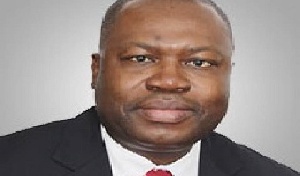 Philip Owiredu, Executive Director at CAL Bank
Philip Owiredu, Executive Director at CAL Bank
Banks could be facing further liquidity challenges as government delays in settling the BDCs debt, Philip Owiredu, Executive Director at CAL Bank, has said.
Following a directive from the Central Bank that banks should classify the BDCs debt as Non-Performing Loans (NPLs), and make provision for same, Mr. Owiredu believes it could push the NPLs beyond 20percent.
The central bank is of the view that since the government has been unable to make payments from the Energy Sector Levy Act (ESLA) Account to banks for the past three months, it is prudent to classify these debts as ‘non-performing’.
"In terms of write offs, I am hopeful that we would not do any further write offs but in terms of complying with the directive of the Central Bank and making provisions for those accounts, that we will have to do. So far as the significant of the BDCs debt has not being paid, I wouldn’t be surprised if it goes beyond 20percent,” he said.
The 2016 Industry Report of the Chamber of Bulk Oil Distributors indicates that out of a about US$401.6million of “validated claims,” government had, as at January, paid about US$261million, leaving an outstanding amount of US$140.6million.
The report indicates, also, that claims that are yet to be validated amount to US$274.55million.
Speaking when Cal Bank took its turn at the Ghana Stock Exchange’s Facts Behind the Figures series, Philip Owiredusaid how soon the debt is cleared will be critical for the health of the banking sector, which is a major lender to the BDCs.
“In terms of liquidity, it is impacting on the banks because these are monies which the various banks have paid and have not being paid back to them. Obviously, that impacts on the banks in terms of its liquidity position and its ability to lend out,” he said.
“In the long run, it is the economy as a whole that is impacted negatively because if the banks are holding back lending, it impacts negatively on the economy as a whole,” he added.
Although the non-performing loans ratio declined marginally from 18percent in January to 17.7percent in February, the situation is worse as compared to the February 2016 figure of 15.6 percent.
After failing to clear the so-called legacy debt with the ESLA, which includes what is owed the BDCs, government has said it is in the process of issuing a US$2billion 15-year bond for that purpose.
Banks performance
Touching on CAL Bank’s performance for 2016 and the first quarter of 2017, Philip Owiredu observed that while performance in 2017 was expected to increase from 2016 figures, the first quarter was not much better as challenges from 2016 were not completely over.
The bank’s total income dropped by 2percent from first quarter from GH¢107.4million to GH¢105.2million while profit after tax dropped by 22.3percent from GH¢40.9million in first quarter 2016 to GH¢31.7million in first quarter 2017.
Breaking down the income earnings, net interest income declined by 3.2percent year on year, which was attributable to higher cost of funds, with trading income also increasing by 64.6percent. This, according to Mr. Owiredu, was due to increased trading volumes and volatilities in the local currency in the quarter.
Credit loss expense increased by 232.5percent due to challenges in the energy and commerce sector loans, with operating expense increasing marginally by 1.7percent due to prudent cost control measures.
The bank, in partnership with the International Finance Corporation (IFC), is set to introduce agency banking over the next two years to drive non-funded income.